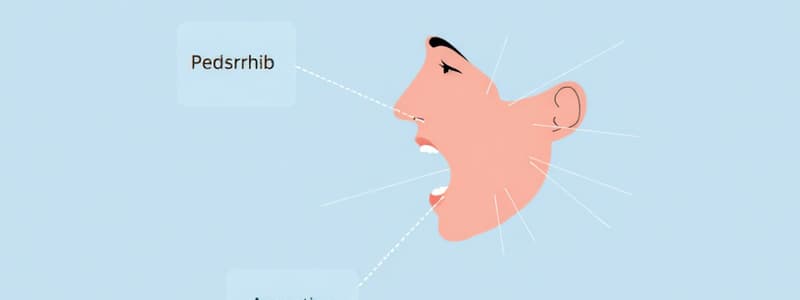Podcast
Questions and Answers
Which of the following sounds is produced by bringing both lips together?
Which of the following sounds is produced by bringing both lips together?
- [d]
- [f]
- [p] (correct)
- [sh]
Which articulation method involves the tip of the tongue between the upper and lower teeth?
Which articulation method involves the tip of the tongue between the upper and lower teeth?
- Bilabials
- Interdentals (correct)
- Labiodentals
- Alveolars
What is the place of articulation for the sounds [k], [g], and [ri(ng)]?
What is the place of articulation for the sounds [k], [g], and [ri(ng)]?
- Bilabials
- Palatals
- Labiodentals
- Velars (correct)
Identify the sounds that are produced using the alveolar ridge.
Identify the sounds that are produced using the alveolar ridge.
Which of the following groups contains only labiodental sounds?
Which of the following groups contains only labiodental sounds?
Which sounds are classified as palatals?
Which sounds are classified as palatals?
Which sounds are produced by touching the bottom lip to the upper teeth?
Which sounds are produced by touching the bottom lip to the upper teeth?
Which group contains sounds produced by bringing both lips together?
Which group contains sounds produced by bringing both lips together?
What type of articulation involves raising the front part of the tongue to the hard palate?
What type of articulation involves raising the front part of the tongue to the hard palate?
Which of the following sets contains only alveolar sounds?
Which of the following sets contains only alveolar sounds?
Which of the following articulations involves inserting the tip of the tongue between the upper and lower teeth?
Which of the following articulations involves inserting the tip of the tongue between the upper and lower teeth?
Which set of sounds is produced by raising the back of the tongue to the soft palate?
Which set of sounds is produced by raising the back of the tongue to the soft palate?
Flashcards
Bilabial sounds
Bilabial sounds
Sounds produced by bringing both lips together.
Labiodental sounds
Labiodental sounds
Sounds produced by touching the bottom lip to the upper teeth.
Interdental sounds
Interdental sounds
Sounds produced by inserting the tongue tip between teeth.
Alveolar sounds
Alveolar sounds
Signup and view all the flashcards
Palatal sounds
Palatal sounds
Signup and view all the flashcards
Velar sounds
Velar sounds
Signup and view all the flashcards
What are bilabials?
What are bilabials?
Signup and view all the flashcards
What are labiodentals?
What are labiodentals?
Signup and view all the flashcards
What are interdentals?
What are interdentals?
Signup and view all the flashcards
What are alveolars?
What are alveolars?
Signup and view all the flashcards
What are palatals?
What are palatals?
Signup and view all the flashcards
What are velars?
What are velars?
Signup and view all the flashcards
Study Notes
Articulatory Phonetics (Places of Articulation)
-
Bilabials: Produced by bringing both lips together. Examples include /p/, /b/, /m/.
-
Labiodentals: Produced by touching the bottom lip to the upper teeth. Examples include /f/ and /v/.
-
Interdentals: Produced by inserting the tip of the tongue between the upper and lower teeth. Examples include /θ/ (hard "th") and /ð/ (soft "th").
-
Alveolars: Produced by raising the tongue in various ways to the alveolar ridge. Examples include /t/, /d/, /n/, /s/, /z/, and /r/. Specific articulations involve various placements of the tongue tip.
-
Palatals: Produced by raising the front part of the tongue to the hard palate. Examples include /ʃ/, /ʒ/, /tʃ/, /dʒ/, and /j/.
-
Velars: Produced by raising the back of the tongue to the soft palate. Examples include /k/, /g/, and /ŋ/.
Studying That Suits You
Use AI to generate personalized quizzes and flashcards to suit your learning preferences.
Description
This quiz covers the different places of articulation in articulatory phonetics. Explore how various speech sounds are made through specific tongue and lip placements, including bilabials, labiodentals, and more. Test your understanding of phonetic categories and examples.



